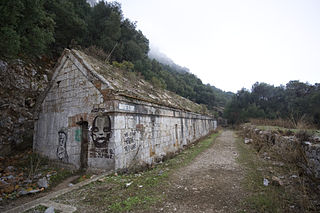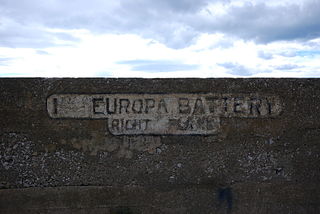Related Research Articles

Wellington Front is a fortification in the British Overseas Territory of Gibraltar. It was built in 1840 on a site established by the Spanish in 1618.

Hesse's Demi Bastion is a demi-bastion in the British Overseas Territory of Gibraltar. It is part of the Northern Defences of Gibraltar. The bastion forms a link in a chain of fortifications which ascend the lower north-west slopes of the Rock of Gibraltar, below the King's Lines Battery and Bombproof Battery. The Moorish Castle's Tower of Homage is at the top of the same incline.

Bomb Proof Battery was an artillery battery near Bomb Proof Barracks in the British Overseas Territory of Gibraltar. The battery was located at the south end of the King's Lines on the north-west face of the Rock of Gibraltar. It comprised a casemated battery built on two levels, each of which had two embrasures built into the old Spanish defences constructed above the then Puerta de Villavieja some time in the 16th century. The battery was partly built over when the King's Lines Battery was constructed.

Buena Vista Battery was an artillery battery near the Buena Vista Barracks at the southern end of the British Overseas Territory of Gibraltar. It is located on a slight ridge in front of the nearby Buena Vista Barracks, which was once the base of the Royal Gibraltar Regiment.

The Europa Batteries are a group of artillery batteries in the British Overseas Territory of Gibraltar. Facing the North African coast, they are the most southerly batteries in Gibraltar and were built to cover ships approaching from the Mediterranean Sea. They run along the fortified clifftops of Europa Point from Camp Bay on the west side of the Rock of Gibraltar to the Europa Advance Batteries on the east side.
Upper Battery is a former artillery battery in the British Overseas Territory of Gibraltar. It was located on the Upper Ridge of the Rock of Gibraltar at a site south of Signal Hill Battery and faced east over the Mediterranean. It mounted two 32-pdrs. in 1861. On the other side of the hill, three 24-pdrs. were mounted at Lower Battery. The two batteries were used for signalling and drill purposes.
Willis' Battery is a former artillery battery on the north side of the British Overseas Territory of Gibraltar. It overlooks the isthmus between Spain and Gibraltar.

The Gibraltar peninsula, located at the far southern end of Iberia, has great strategic importance as a result of its position by the Strait of Gibraltar where the Mediterranean Sea meets the Atlantic Ocean. It has repeatedly been contested between European and North African powers and has endured fourteen sieges since it was first settled in the 11th century. The peninsula's occupants – Moors, Spanish, and British – have built successive layers of fortifications and defences including walls, bastions, casemates, gun batteries, magazines, tunnels and galleries. At their peak in 1865, the fortifications housed around 681 guns mounted in 110 batteries and positions, guarding all land and sea approaches to Gibraltar. The fortifications continued to be in military use until as late as the 1970s and by the time tunnelling ceased in the late 1960s, over 34 miles (55 km) of galleries had been dug in an area of only 2.6 square miles (6.7 km2).

The Inundation was a flooded and fortified area of ground on the sandy isthmus between Spain and Gibraltar, created by the British in the 18th century to restrict access to the territory as part of the fortifications of Gibraltar. It was originally a marshy area known as the Morass at the far south-western end of the isthmus, occupying the area adjacent to the north-western flank of the Rock of Gibraltar. The Morass was dug out and expanded to create an artificial lake which was further obstructed by iron and wooden obstacles in the water. Two small fortifications on either side controlled access to Gibraltar. The only road to and from the town ran along a narrow causeway between the Inundation and the sea which was enfiladed by batteries mounted on the lower slopes of the Rock. The Inundation existed for about 200 years before it was infilled and built over after the Second World War.

The King's Lines are a walled rock-cut trench on the lower slopes of the north-west face of the Rock of Gibraltar. Forming part of the Northern Defences of the fortifications of Gibraltar, they were originally created some time during the periods when Gibraltar was under the control of the Moors or Spanish. They are depicted in a 1627 map by Don Luis Bravo de Acuña, which shows their parapet following a tenaille trace. The lines seem to have been altered subsequently, as maps from the start of the 18th century show a more erratic course leading from the Landport, Gibraltar's main land entrance, to the Round Tower, a fortification at their western end. A 1704 map by Johannes Kip calls the Lines the "Communication Line of the Round Tower".
The Prince of Wales Batteries were a group of artillery batteries built in Gibraltar between 1859–60 and named after Albert Edward, Prince of Wales, who laid the batteries' foundation stone on 13 May 1859. They stood on the West Side of Gibraltar, facing the sea, and were constructed on top of the former Prince Henry's Battery, built during the Anglo-Spanish War of 1762–3. The batteries were originally intended to mount four 32-pdr guns but they were extended to mount eleven guns in four groups. They were rebuilt again around 1872 when two new gun emplacements were built on top of Nos. 2 and 3 batteries to accommodate two 9-inch rifled muzzle loader guns.
Prince Henry's Battery was an artillery battery built in Gibraltar during the Anglo-Spanish War of 1762–63, adjoining the Prince of Wales Lines. They mounted three 32-pdr guns with two more 18-pdrs, six 12-pdrs and three 4-pdrs on the Lines. After 1841, the battery was rebuilt as a retired battery as part of a mid-19th century remodelling of Gibraltar's southern defences. They were eventually built over in 1859–60 when the Prince of Wales Batteries were constructed on the same site.

The Queen's Lines are a set of fortified lines, part of the fortifications of Gibraltar, situated on the lower slopes of the north-west face of the Rock of Gibraltar. They occupy a natural ledge which overlooks the landward entrance to Gibraltar and were an extension to the north-east of the King's Lines. They run from a natural fault called the Orillon to a cliff above the modern Laguna Estate, which stands on the site of the Inundation, an artificial lake created to obstruct landward access to Gibraltar. The Prince's Lines run immediately behind and above them on a higher ledge. All three of the Lines were constructed to enfilade attackers approaching Gibraltar's Landport Front from the landward direction.
The North Mole Elbow Battery was an artillery battery situated on Gibraltar's Old Mole, at the point where the mole turns north. It is recorded as mounting three 12-pdr guns in 1903. It mounted a Bofors 40 mm anti-aircraft gun during the Second World War along with a 6-pdr gun on a twin mounting for coastal defence purposes. At the end of the mole, another 6-pdr gun was installed on a twin mounting.
Ragged Staff Flank is a masonry fortification on the South Front of Gibraltar's fortifications. It continues the line of the South Bastion's seaward face across the South Front ditch, then turns to form a flanking position facing south along the coastal fortifications leading to the New Mole. The Ragged Staff Gates were situated in the middle of the flank, leading to the Ordnance Wharf that was located where the Dockyard North Gate used to stand. A defended enclosure stood behind the gate, secured by the Ragged Staff Guardhouse. The flank position had three embrasures in its parapet but only mounted two 24-pdr guns in 1779, though these were replaced by 32-pdrs under the rearmament plan of 1859.

Prince Albert's Front is a curtain wall that formerly comprised part of the seafront fortifications of Gibraltar. It runs between the King's Bastion and Orange Bastion. The Front was constructed in 1842 after a report by Major General Sir John Thomas Jones recommended improving Gibraltar's seafront defences to guard against the threat of an amphibious assault. It was named after Prince Albert, Queen Victoria's prince consort. The Front straightened out the line of Gibraltar's coastal curtain wall; parts of the original curtain wall, some of which dates from the Moorish period over 500 years ago, can still be seen.

The Prince's Lines are part of the fortifications of Gibraltar, situated on the lower slopes of the north-west face of the Rock of Gibraltar. They are located at a height of about 70 feet (21 m) on a natural ledge above the Queen's Lines, overlooking the landward entrance to Gibraltar, and run from a natural fault called the Orillon to a cliff at the southern end of the isthmus linking Gibraltar with Spain. The lines face out across the modern Laguna Estate, which stands on the site of the Inundation, an artificial lake created to obstruct landward access to Gibraltar. They were constructed to enfilade attackers approaching Gibraltar's Landport Front from the landward direction.

The West Place of Arms is a place-of-arms in the British Overseas Territory of Gibraltar that was originally used as a troop assembly point. It is located in the gap between the North Bastion and its Counterguard, a structure built in 1804.

Victoria Battery was an artillery battery in the British Overseas Territory of Gibraltar. It was built in the 1840s on top of the earlier Princess of Wales Batteries following a report by Major-General Sir John Thomas Jones on Gibraltar's defences. The battery was located on the west side of Gibraltar and was one of a number of "retired" batteries in the territory, constructed to improve the coastal defences between Europa Point and the town.
References
- ↑ Hughes & Migos, p. 341